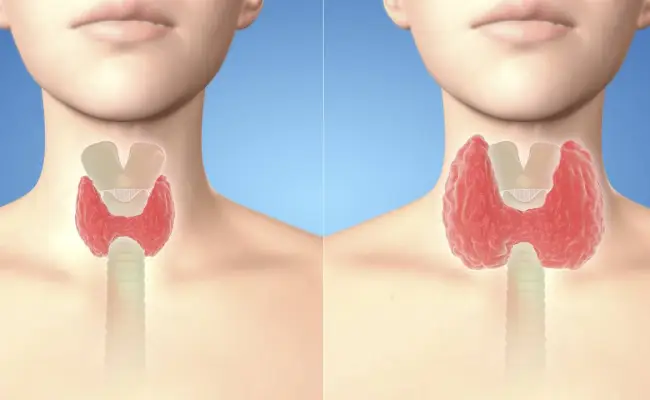Feeling the conflicting symptoms of both hyper and hypothyroidism? You’re not alone! Explore the reasons behind this thyroid tango and discover steps to a healthy rhythm.
The thyroid gland, a butterfly-shaped organ at the base of your neck, plays a vital role in regulating your metabolism. When it functions normally, it produces just the right amount of thyroid hormones, keeping your body’s processes running smoothly. But sometimes, the thyroid throws a wrench into the works, leading to either hyperthyroidism (overactive) or hypothyroidism (underactive). The question then arises: can one person experience both hyperthyroidism and hypothyroidism?
The Short Answer:
Generally, a person cannot have both hyperthyroidism and hypothyroidism simultaneously. These conditions represent opposite ends of the thyroid function spectrum. However, there are situations where someone might experience a transition between hyperthyroidism and hypothyroidism, or even have symptoms suggestive of both conditions at different times.
Understanding the Why:
Thyroid hormones, T3 and T4, influence various bodily functions, from metabolism and energy levels to heart rate and mood.
- Hyperthyroidism: When the thyroid produces too much hormone, the body goes into overdrive. Symptoms include weight loss, rapid heartbeat, anxiety, tremors, and difficulty sleeping.
- Hypothyroidism: Conversely, an underactive thyroid results in insufficient hormone production. This leads to fatigue, weight gain, feeling cold, constipation, and depression.
The Shifting Landscape:
While a person can’t have both hyperthyroidism and hypothyroidism at the same time, their thyroid function can fluctuate over time, leading to a transition between these states. Here’s how:
- Autoimmune Disorders: Autoimmune conditions like Graves’ disease can cause hyperthyroidism. However, in some cases, the immune system might attack the thyroid too aggressively, eventually destroying thyroid tissue. This leads to a shift towards hypothyroidism.
- Treatment Effects: Anti-thyroid medications used to treat hyperthyroidism can sometimes swing the pendulum too far, leading to temporary hypothyroidism. This usually requires adjusting the medication dosage.
- Thyroiditis: This inflammation of the thyroid gland can initially cause a burst of thyroid hormone release (temporary hyperthyroidism), followed by a period of decreased hormone production (hypothyroidism).
Living in the Gray Area:
It’s important to note that some people might experience symptoms that seem like a blend of hyperthyroidism and hypothyroidism. However, this often reflects underlying issues like:
- Nutrient Deficiencies: Iodine deficiency, for example, can lead to symptoms that mimic both hyperthyroidism and hypothyroidism.
- Medications: Certain medications can have side effects that resemble symptoms of either hyperthyroidism or hypothyroidism.
- Stress: Chronic stress can disrupt thyroid function and manifest as symptoms that seem like a mix of both conditions.
Diagnosis is Key:
If you suspect you might be experiencing both hyperthyroidism and hypothyroidism, or have symptoms that don’t clearly fit either category, it’s crucial to see a doctor. Through a combination of:
- Blood tests: These measure thyroid hormone levels (T3, T4, TSH) to check for over or underproduction.
- Imaging tests: An ultrasound or radioactive iodine uptake scan might be used to visualize the thyroid gland and assess its function.
- Physical examination: The doctor will review your medical history, symptoms, and perform a physical exam to gather additional information.
The Path to Treatment:
The treatment for your condition will depend on the specific cause of your thyroid dysfunction. Here are some possibilities:
- Hyperthyroidism: Anti-thyroid medications, radioactive iodine treatment, or surgery might be used to control an overactive thyroid.
- Hypothyroidism: Synthetic thyroid hormone replacement therapy is the mainstay of treatment for hypothyroidism.
- Underlying Issues: If nutrient deficiencies, medications, or stress are contributing factors, addressing those will help manage your thyroid function and improve overall health.
Living a Balanced Life
With proper diagnosis, treatment, and regular monitoring, people with fluctuating thyroid function can lead healthy and fulfilling lives. Here are some tips:
- Follow your doctor’s recommendations: Stick to your medication schedule and attend follow-up appointments.
- Maintain a healthy lifestyle: Eat a balanced diet, exercise regularly, and manage stress effectively.
- Be mindful of symptoms: Pay attention to how you feel and report any changes to your doctor.
- Consider support groups: Connecting with others who understand the challenges of thyroid dysfunction can be helpful.





